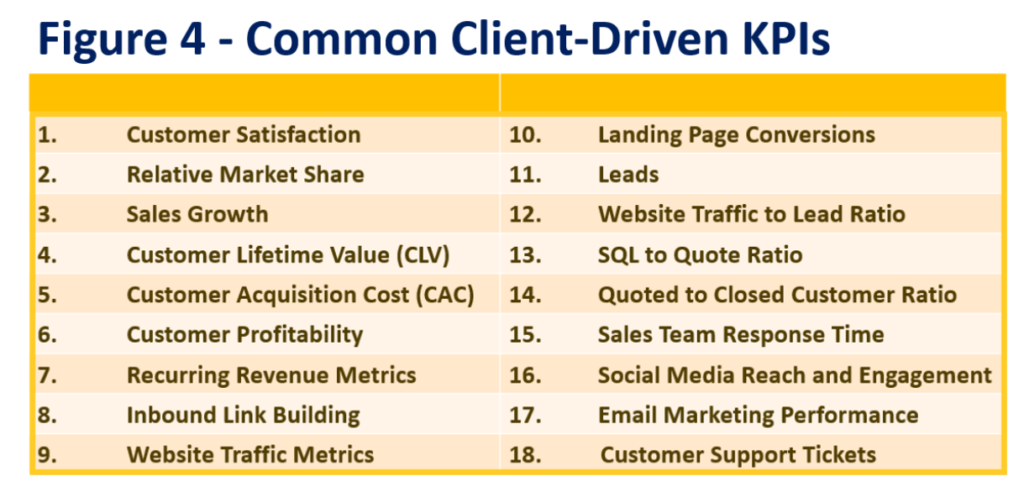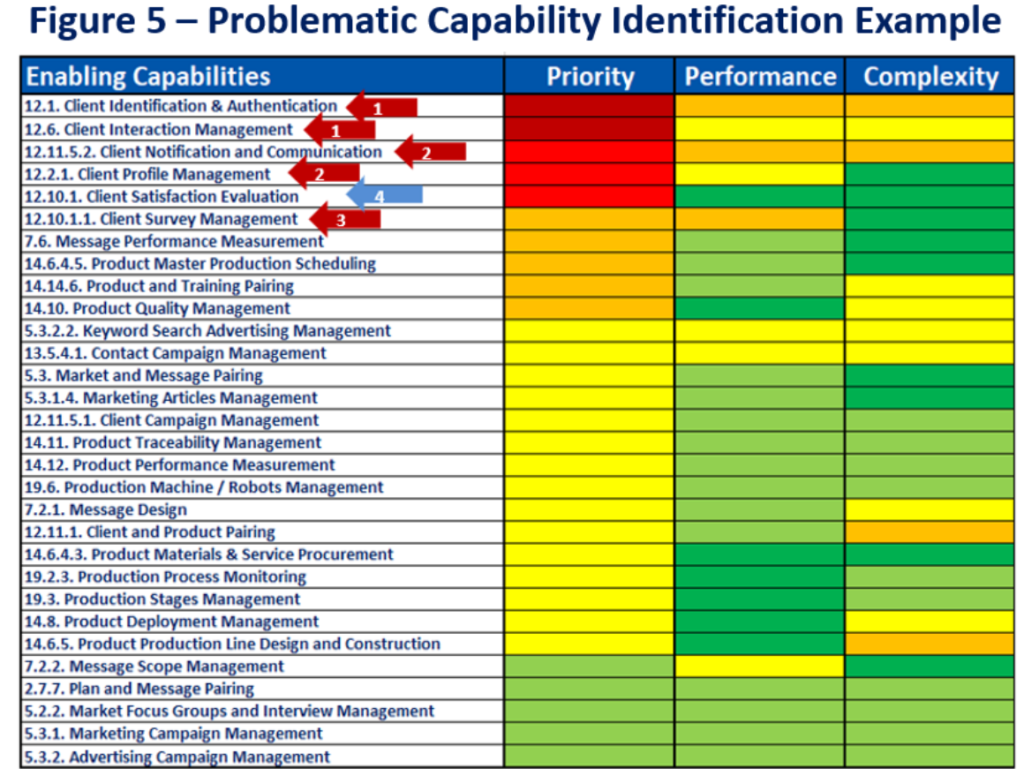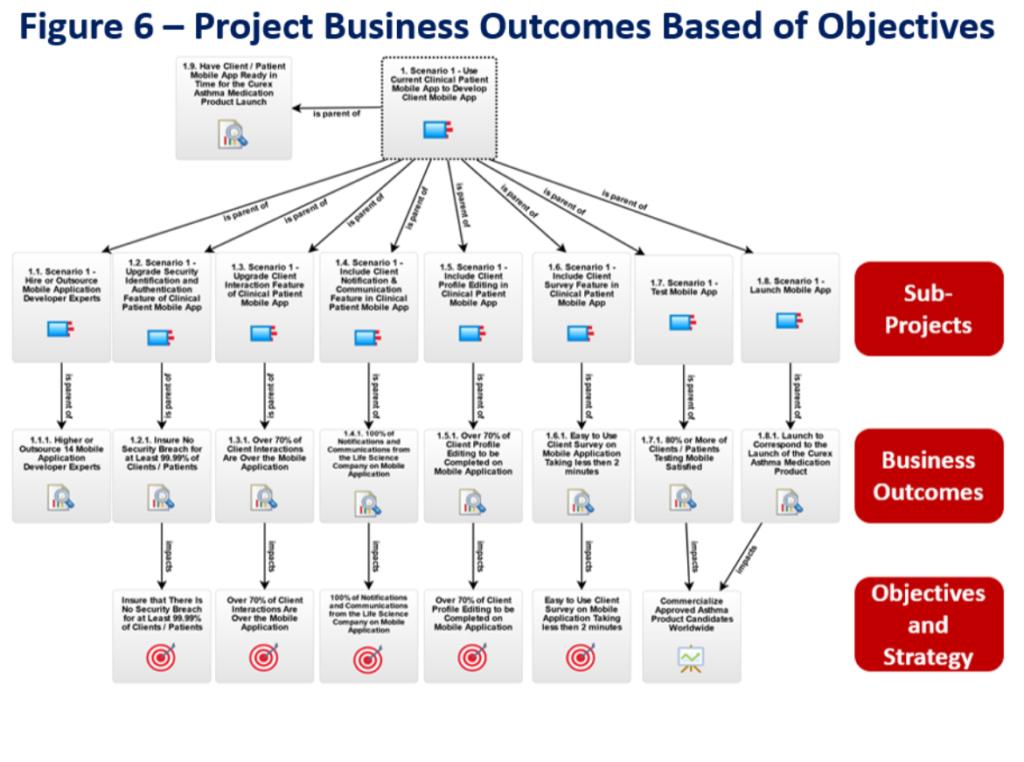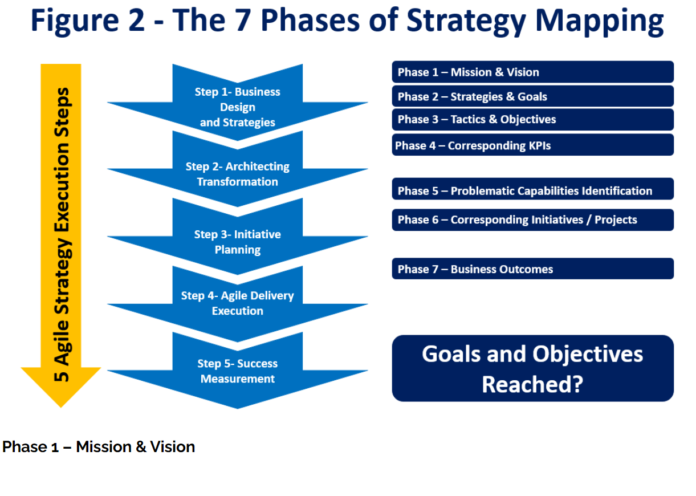The 7 Phases of Strategy Mapping
by Daniel Lambert
Well-crafted strategic plans are mapped in detail from business design to agile solution delivery and execution to enable the necessary changes within an organization in response to customer needs, competition, and innovation. To achieve its strategies and goals, a firm needs to map and disseminate them cohesively throughout its organization using its entire planning ecosystems from executives, mid-level managers, strategists, business architects, enterprise architects, change managers, process experts, business analysts, and agile experts using the 7 phases of strategy mapping.
Benefits of Strategy Mapping
According to the Harvard Business Review, “Most digital transformations fail. Various studies from academics, consultants, and analysts indicate that the rate of digital transformations failing to meet their original objectives ranges from 70% to 95%, with an average of 87.5%.[i]”, as I’ve pointed out in this article entitled “Increasing your Digital Transformation Success Rate with Enterprise Architecture”. The reasons for such failures are usually because HR and IT organizations develop strategic plans that are not linked to the enterprise strategy and because most employees do not understand their organization’s strategy to the point where 37-40% of workers according to surveys say their jobs make no difference according to the Economist[ii].

To work, strategy mapping needs to closely align to the five agile strategy execution steps described in this book entitled “Practical Guide to Agile Strategy Execution: Design, Architect, Prioritize, and Deliver your Corporate Future Successfully” and shown in Figure 1 above. Strategy mapping has five benefits for organizations of all sizes. Firstly, it clarifies a firm’s purpose and direction, ensuring that everyone involved in the organization is working cohesively towards the same strategies and goals. Secondly, strategy mapping enables an organization to anticipate and react to changes in its internal and external environments, such as shifts in market trends, new competitive threats, changes in regulations, and the arrival of new innovations for example. Thirdly, strategy mapping allows prioritizing and ensuring that resources, including time, money, and personnel, are used effectively. Finally, strategy mapping provides a basis for ongoing assessments, allowing a company to continuously achieve its strategies and goals over time.
Strategy mapping in an agile strategy execution setting includes 7 phases, as shown in Figure 2 below. They are 1- mission and vision, 2- strategies and goals, 3- tactics and objectives, 4- corresponding KPIs, 5- problematic capabilities identification, 6- Corresponding initiatives or projects, and 7- business outcomes.
The seven phases of Strategy Mapping
Phase 1 – Mission & Vision
A Mission is a short statement of why an organization exists and is often specified more precisely with a Vision statement to be achieved within a finite time frame and made of a series of long-term goals and short-term objectives. As shown in Figure 3 below.
Phase 2 – Strategies & Goals
Strategies consist of high–level plan items that also include short-term Tactics to achieve an organization’s major goals under conditions of uncertainty. A Goal is the desired result that an organization envisions, plans, and commits to achieve within a finite time frame.
Phase 3 – Tactics & Objectives
As for Objectives, they are essentially short-term goals whose achievement brings an organization closer to its long-term goals. Goals are derived from strategies, which are conceptual long-term actions to deliver and execute a strategy. Objectives are derived from tactics, which are conceptual short-term actions to deliver and execute a tactic.

Phase 4 – Corresponding KPIs
Each goal and objective can be measured by its corresponding key performer indicators. These can be operational, financial, or client-driven as shown in Figure 4 below.

Phase 5 – Problematic Capabilities Identification
Often through the examination of value streams and sometimes customer journeys, business architects should then identify the problematic capabilities that need to be fixed for an organization to reach its goals and objectives.

Measuring enabling capabilities of a value stream or a customer journey, as shown in Figure 5 above, according to their priority, performance, and business complexity, for example, will allow the identification of problematic capabilities that need to be enhanced to reach the goals and objectives of the organization. In this example, enabling business capabilities are sorted first by their priority, performance, and complexity. It enables the detection of the most problematic business capabilities, indicated here by a red arrow. These are of very high or critical priority and perform at a low level. In case there are too many problematic capabilities, starting initiatives on the less business complex initiatives will enable quicker delivery and execution of improved business capabilities.
Phase 6 – Corresponding Initiatives / Projects
For each identified problematic capability, an initiative or project needs to be examined. This is usually completed by examining several scenarios based on financial ratios and risk factors. After the complete analysis of all scenarios relating to all identified problematic capabilities, a final scenario should be selected and become the business digital transformation roadmap of the organization. It will need to be described in detail. The roadmap should be broken into multiple projects, sub-projects, and sprints, laying out their nomenclature and GANTT Chart.
Phase 7 – Business Outcomes
Each project and sub-project composing the business digital transformation should include appropriate budgeted human and capital resources that should be used in a specific timeframe and should finally aim at a precise business outcome, as shown in Figure 6 below. Setting a definition of a milestone may only be technical, but each business outcome should be derived from precise and detailed goals and objectives defined in phase 3 of your strategy mapping.

In brief, to realize its strategies and goals, an organization needs to map and disseminate them cohesively throughout its organization using its entire planning ecosystems using the 7 phases of strategy mapping. It’s really the only way to really improve the success rate of digital transformations.
——————————
[i] This quote is extracted from the article entitled “3 Stages of a Successful Digital Transformation” written by Didier Bonnet in September 2022 and published on the Harvard Business Review website.
[ii] Percentage quoted in this article are extracted from the article entitled “Bullshit Jobs and the Yoke of Managerial Feudalism” published in The Economist on June 29, 2018.

